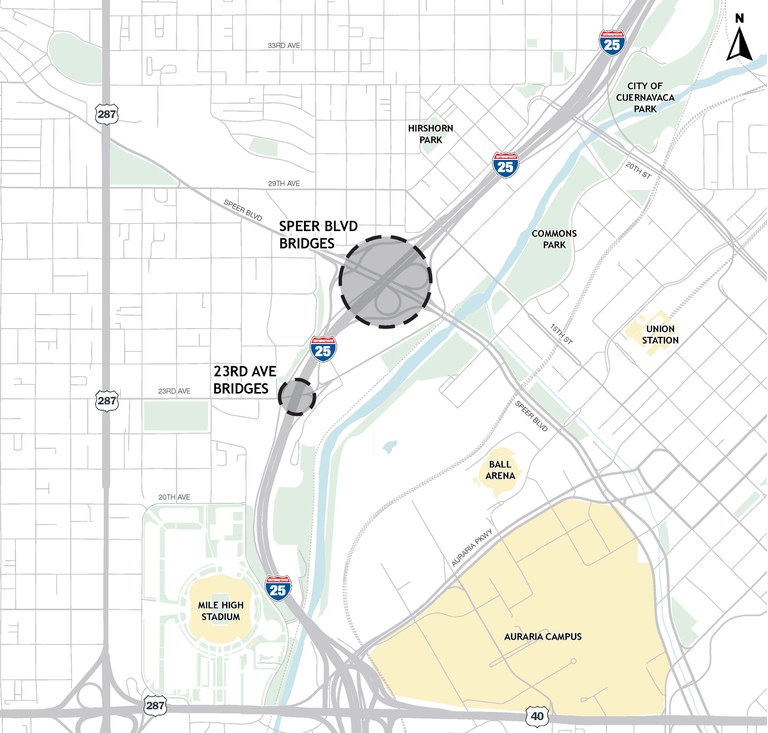I-25: Speer & 23rd Bridge Interchange | National Environmental Policy Act & Preliminary Design
About the Project
This project will replace the bridges at Speer Boulevard and 23rd Avenue over Interstate 25 in Denver.
The I-25: Speer Boulevard and 23rd Avenue Bridge and Interchange project will:
- Improve safety in interchange complex
- Provide interstate crossings that have adequate clearance over I-25 and structural integrity
- Accommodate pedestrians, bicycles and other micro mobility devices (small, low-speed, human or electric-powered transportation devices) across I-25 and along Speer Boulevard and 23rd Avenue
Project Area

Schedule & Important Dates
- 2023: Data collection and preliminary alternatives development
- Early 2024: Purpose and need developed, and initial screening
- Mid-2024: Alternative refinement and secondary screening
- Late 2024 to 2025: NEPA analysis and documentation, start of preliminary design
- 2026 and Beyond: Finalize preliminary design and NEPA analysis, identify construction delivery method and identify construction funds
CDOT launched the I-25: Speer & 23rd Bridge & Interchange Project during the Summer of 2021 to study and evaluate replacing the bridges that cross over I-25 in Central Denver. These bridges are near the end of their useful life and are often struck by trucks due to deficient vertical clearance. They are in need of replacement for the safety of all travelers.
In the fall of 2025, CDOT reached a key project milestone by identifying the Proposed Action to be carried forward into preliminary design and NEPA evaluation. The Proposed Action is a combination of the 23rd Avenue Braided Ramp and the Speer Boulevard Diverging Diamond Interchange. The Proposed Action fulfills the project Purpose and Need while also balancing stakeholder needs identified via the public engagement process. The decision-making process involved collaboration between CDOT project management and technical teams, City and County of Denver, local stakeholders including local residents, businesses, and community organizations.
Finalize preliminary design and complete NEPA analysis with Proposed Action.
Identify Corridor Needs (Data Collection and Analysis)
Existing conditions data, such as the condition of the highway and bridges or the locations of rail, bicycle and pedestrian facilities, and transit, were collected during the I-25 Central PEL. Supplemental data has been collected for this project, which includes environmental resource information and traffic and safety data. This information helped refine the needs of the corridor and the development of the purpose and need.
Alternatives Refinement and Evaluation
Building on the recommended alternatives from the PEL, alternatives will be refined according to the identified needs and evaluated to determine the preferred alternative for the project.
Environmental Analysis and Documentation (NEPA)
Once a preferred alternative is identified, it will be analyzed for the potential to cause environmental and human effects. These effects will be documented through the NEPA process.
Public and Stakeholder Involvement
The project is working with community members and stakeholders to ensure that community interests and concerns are understood and linked to project decision-making. Engagement activities will occur through the duration of the project and will include:
- Community-based Stakeholder Group
- Close communication with the City of Denver
- Virtual and in-person activities
- Public meetings
- E-notification updates (Sign up in the "Stay Informed" section)
